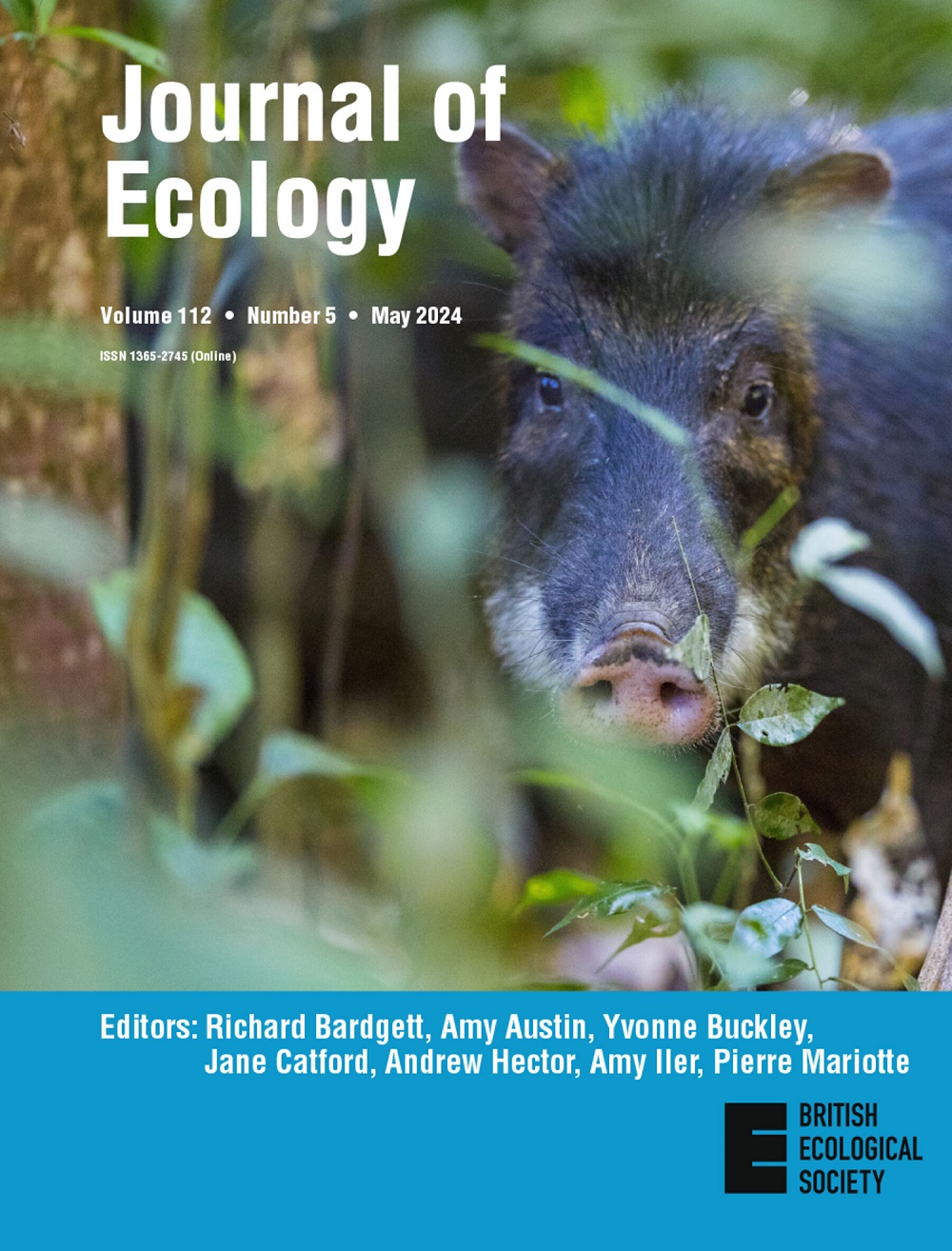遥感揭示了河岸杨树(Populus spp)对干旱响应的种间和种内变化
IF 5.6
1区 环境科学与生态学
Q1 ECOLOGY
引用次数: 0
摘要
气候变化加剧了许多地区的干旱状况(戴,2011;Stocker et al., 2014),增加植被胁迫、植物死亡率和生物多样性丧失,同时破坏关键的相互作用和生态系统稳定性(Allen et al., 2010;Au等人,2023;Steinkamp,Hickler, 2015;Stone et al., 2018)。长期和严重的干旱条件威胁着重要的生态系统服务(Breshears et al., 2011;狼,Paul-Limoges, 2023),但森林已经表现出对水压力的恢复力和适应能力(Amlin &;十字架,2003;Anderegg et al., 2018;Phelan et al., 2022)。这种恢复力可以由基因型-环境(G × E)相互作用驱动,因为种内和种间变化都会影响生态系统对干旱的反应(Anderegg等人,2018;Grossiord, 2020;Rodríguez-Alarcón et al., 2022)。遥感是一种强大的非破坏性工具,可用于在多个尺度上检查G × E相互作用,捕捉森林对不同物种、种群和景观的水资源压力的反应。光谱学和热成像对于研究干旱环境下的G × E相互作用特别有效,因为它们可以捕获跨时空尺度对水分胁迫的生理反应(Cotrozzi等人,2017;Le et al., 2023;Li et al., 2023;Sapes et al., 2024)。光谱学,通过短波红外(VSWR)捕获可见光数据;在较短的波长间隔(例如1-10 nm), 350-2500 nm的光谱,使我们能够检测到指示水分胁迫的植物性状的变化(例如,再水合能力、叶片水势、相对含水量、电解质泄漏),然后再看到它们(Cotrozzi等人,2017;Mohd Asaari等,2022;Sapes et al., 2024)。水分胁迫(被量化为冠层含水量)已通过成像光谱在大空间尺度上进行估算(Asner等人,2016)。这些数据进一步捕获了其他叶片性状的变化(如每面积叶质量、叶绿素含量;Asner,Martin, 2016),在叶片和景观水平上提供植物表型的非破坏性测量。虽然整个VSWIR光谱用于捕捉植物的生理反应,但特定区域提供了不同的信息:可见光范围(400-700 nm)主要反映叶绿素等光合色素,近红外(NIR;750-1300 nm)检测细胞结构和含水量的变化,短波红外(SWIR;1300 - 2500nm)通常表示非光合植物特性,如木质素和单宁(Asner &;马丁,2016)。此外,Corbin等人(2025)最近的研究表明,光谱学可以很好地区分种群和基因型,并检测fremontii(本研究中使用的物种之一)的G × E相互作用。通过检测不同环境下的干旱胁迫和表型反应,光谱学捕获了植物的水分利用策略和适应能力,为推进我们对当地适应、群落结构、植物化学和胁迫反应的理解奠定了基础,并为通过热成像等互补遥感方法将这些分析扩展到更广泛的空间范围奠定了基础。热成像是在大空间尺度上调查水利用策略、植物水分状况和抗旱性差异的另一个重要遥感工具(Fuchs, 1990;Scherrer et al., 2011)。当水分供应有限时,由蒸腾作用通过蒸发冷却(潜热损失)介导的叶片和冠层温度升高,使热成像成为水分胁迫的可靠指标。这种方法已经成功地应用于植物和生态系统科学中,使用了塔、无人机(uav)和卫星等平台(Farella et al., 2022)。通过在景观尺度上捕捉G × E相互作用,热成像和光谱为理解气候变化加剧许多地区干旱时生态系统的反应提供了一种手段。考虑到在气候变化背景下理解G × E相互作用的重要性日益增加,杨木为研究树木的水分胁迫提供了理想的案例研究,因为它们具有显著的种内和种间变异,这些变异介导了它们对环境压力的反应(Blasini等人,2021,2022;Bothwell et al., 2023;Hultine et al., 2020;Kaluthota et al., 2015;Moran et al., 2023;Woolbright et al., 2008)。两种白杨,白杨。和P. angustifolia James)及其自然产生的杂交种在整个美国西南部的河岸地带共存,但它们的水力特性也不同。与姊妹树种P. angustifolia(窄叶棉)相比,fremontii(白杨)的冠层导度更高(Fischer et al., 2004),气孔对生长季节累积蒸汽压赤字的敏感性更低;郭等人,2022)。此外,费氏假单胞菌与费氏假单胞菌杂交。 安古斯提叶表现出独特的遗传和生态特征,例如形成由F1杂交和回交基因型组成的杂交带,具有增强耐旱性的潜力(Hultine et al., 2020;Martinsen et al., 2001;Whitham et al., 1999)。杂种因其独特的遗传组合(f1到回交;Hersch-Green等人,2014年)为应对气候变化的选择和进化潜力提供了目标(见Peñalba等人,2024年的评论)。这两种杨树的抗旱能力是一个紧迫的保护问题,因为它们构成了基础物种(Hultine等人,2020),部分原因是水资源限制,导致美国西南部河岸生态系统的衰退(Braatne等人,1996;Hultine et al., 2020;Stromberg, 2001;Stromberg et al., 1996)。种内差异——很大程度上是由过去的气候条件形成的——在物种耐受水分胁迫的能力中也起着关键作用(Gazol et al., 2023;González de andr<s:1>等人,2021;Jung et al., 2014;罗等人,2023)。在fremontii中,种内变异是明显的,种群表现出对温度和水分供应的不同生理适应,这与在其范围内识别不同的生态型是一致的(Bothwell等人,2023;Hultine et al., 2020;池田等人,2017)。例如,适应温暖的fremontii种群在热浪期间利用高蒸腾速率将叶片温度保持在热阈值以下(Blasini et al., 2021;Moran et al., 2023;Posch et al., 2024)。然而,与适应冷却的种群相比,这种更大的叶片冷却能力的代价是更接近水力失效阈值(Blasini等人,2021;Posch et al., 2024),因为它们对干旱诱导的木质部空化非常敏感(Leffler et al., 2000;Tyree et al., 1994)。利用叶级VSWIR光谱和冠层级无人机热数据,研究了棉杨(Populus spp.)种内和种间干旱响应的G × E相互作用。首先,利用两个温室干旱试验中收集的叶片VSWIR反射数据,研究了三种杨树杂交类型fremontii、angustifolia及其杂交种的种间干旱响应。我们重点量化了它们在环境胁迫下的光谱位移和表型收敛,并假设,尽管干旱会导致三种杂交类型的光谱空间发生位移,但无论干旱状况如何,它们的光谱都是不同的。此外,我们通过评估源种群平均年温度(MAT)的变化如何影响叶片水平VSWIR和冠层水平无人机(UAV)的两个常见花园热数据,评估了fremontii种内G × E相互作用。我们假设,种内光谱和对干旱的热响应反映了历史上对高温和干旱的气候适应,而暖适应种群在干旱前会表现出较低的叶温,但受干旱的影响比冷适应种群更大。通过利用遥感研究基础树种的干旱响应,我们试图探索和证明遥感作为量化和监测在局部到景观尺度上对环境压力响应的种内和种间变化的工具。本文章由计算机程序翻译,如有差异,请以英文原文为准。





Remote sensing reveals inter- and intraspecific variation in riparian cottonwood (Populus spp) response to drought
求助全文
通过发布文献求助,成功后即可免费获取论文全文。
去求助
来源期刊

Journal of Ecology
环境科学-生态学
CiteScore
10.90
自引率
5.50%
发文量
207
审稿时长
3.0 months
期刊介绍:
Journal of Ecology publishes original research papers on all aspects of the ecology of plants (including algae), in both aquatic and terrestrial ecosystems. We do not publish papers concerned solely with cultivated plants and agricultural ecosystems. Studies of plant communities, populations or individual species are accepted, as well as studies of the interactions between plants and animals, fungi or bacteria, providing they focus on the ecology of the plants.
We aim to bring important work using any ecological approach (including molecular techniques) to a wide international audience and therefore only publish papers with strong and ecological messages that advance our understanding of ecological principles.
 求助内容:
求助内容: 应助结果提醒方式:
应助结果提醒方式:


